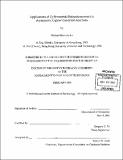Applications of C₂-symmetric bis(azaferrocenes) in asymmetric copper-catalyzed reactions
Author(s)
Lo, Michael Man-chu, 1971-
DownloadFull printable version (21.62Mb)
Other Contributors
Massachusetts Institute of Technology. Dept. of Chemistry.
Advisor
Gregory C. Fu.
Terms of use
Metadata
Show full item recordAbstract
Based on a strategy developed in our group for the desymmetrization of planar heterocycles, we have designed, synthesized, and resolved a number of bidentate, C2-symmetric planar-chiral bis(azaferrocenes) that bear a structural resemblance to the highly versatile bis(oxazolines). These bis(azaferrocenes) have their stereogenic elements directly connected to their ligating atoms, which should help these heterocycles exert better stereodifferentiating ability when they are applied as ligands in metal-catalyzed processes. To validate the ligand design, we first applied our C2-symmetric bis(azaferrocenes) as ligands in the asymmetric copper-catalyzed cyclopropanation of olefins. We discovered that one of these ligands is particularly effective, and using a hindered diazo ester, an array of monosubstituted olefins has been cyclopropanated with excellent diastereo- as welf as enantioselectivity. The level of stereoselection achieved is comparable to some of the best ligands reported to date. Preliminary studies also showed that trans and trisubstituted olefins can be excellent substrates for the ligand. The same copper-bis(azaferrocene) complex also catalyzes the ring expansion of oxetanes into tetrahydrofurans with high stereoselection. In the optimization process, we have developed a new hindered diazo ester that may also prove useful in other asymmetric carbene transfer processes. With the catalyst controlling the stereochemistry of the newly established C2 carbon and the oxetane substrate defining the configuration at the C3 carbon, the ring expansion furnishes either diastereomer of a 3-substituted tetrahydrofuran-2-carboxylate with high stereoselectivity. (cont.) The Kinugasa reaction, which is the copper-mediated reaction between nitrones and terminal alkynes, is an underexplored synthetic pathway to 2-azetidinones. Using a bis(azaferrocene) as the ligand, we have successfully improved the Kinugasa reaction in the following aspects: (1) the reaction is catalytic in copper; (2) the reaction gives high cis diastereoselectivity; and, (3) the reaction is highly enantioselective with a variety of nitrones and alkynes. Combined with a subsequent epimerization, our enantioselective process represents the first general, catalytic system for the Kinugasa reaction, which provides stereoselective access to all four of the possible isomers.
Description
Thesis (Ph.D.)--Massachusetts Institute of Technology, Dept. of Chemistry, 2002. Vita. Includes bibliographical references.
Date issued
2002Department
Massachusetts Institute of Technology. Department of ChemistryPublisher
Massachusetts Institute of Technology
Keywords
Chemistry.
